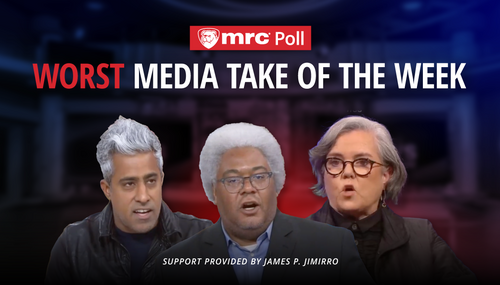In a separate post critiquing Associated Press reporter Stephen Ohlemacher's Monday evening and Tuesday morning dispatches on President-Elect Donald Trump's Electoral College victory, I noted that Ohlemacher gave undue ink and bandwidth to no more than 1,500 to 2,100 protesters in states Trump won who urged Republican electors not to carry out their Constitutional duty.
Ohlemacher believed that he could comfortably claim that "thousands" were involved in these protests because he included those in states won by Hillary Clinton. That's bogus, as there were no Republican electors to persuade in those states.
Ohlemacher's story also made a seriously deficient claim about the alleged shortcomings of the Electoral College.
Sticking to the undue attention given to the protesters for just one more moment, there were six photos AP presented with Ohlemacher's Monday evening report. Taking the first three, those were of the relatively insignificant number of protesters in Pennsylvania ("more than 200," per Ohlemacher), Texas ("dozens," per local coverage), and Kansas ("more than 50," per local coverage).
As to the alleged unfairness of the Electoral College, the AP reporter wrote:
The Electoral College has 538 members, with the number allocated to each state based on how many representatives it has in the House plus one for each senator. The District of Columbia gets three, despite the fact that the home to Congress has no vote in Congress.Some Democrats have argued that the Electoral College is undemocratic because it gives more weight to less populated states. That is how Clinton, who got more than 2.8 million more votes nationwide, lost the election to Trump.
The core of this argument made by "some Democrats," according to Ohlemacher, has to do with the "weight given to less populous states," and not with candidates' victory margins within those states. That argument doesn't work — and it isn't their real argument anyway.
An AP graphic presented as the last in that six-photo series tries to make Ohlemacher's point. The problem is that it doesn't answer the complaint of "some Democrats":
The "over-representation" of less-populous states didn't give any meaningful advantage to Trump. Two of the three "worst" instances of over-representation were Vermont and DC, which voted for Clinton. Trump carried only eight of the 15 most "over-represented" states, while also carrying one congressional district in Maine.
Meanwhile, four of the six most "under-represented" states went to Trump. If anyone was hurt by under-representation, it was Mr. Trump. Why? For two reasons. First, because Trump carried Ohio and Florida, which have been swing states in recent elections, and Pennsylvania, which only swung this year for the first time in decades.
Second, congressional districts were drawn based on the 2010 census, and lots of people have moved to Texas and Florida in the past six years, creating a new layer of under-representation. If congressional districts were reallocated based on 2016 census figures, it's virtually certain that those two states would pick up a combined three or more electoral votes, while New York, which went to Clinton, would lose at least one.
Let's take it one step further, and show how a mythical Electoral College vote would have turned out if the states were only allowed electors based on their cadre of House members (plus DC's single non-voting member), which is the best proxy for relative statewide populations while still fitting into a constitutional framework:
The table shows that the left's complaint about the Electoral College giving small red states too much representation this year simply isn't so. The mythical and actual electoral college vote percentages are virtually identical.
The small-state complaint has no constitutional validity; the Electoral College includes members representing each state's senators precisely because the Founders did not want large states to run over the small ones. That said, the small-state complaint has mathematical validity in certain instances. Al Gore would have won the 2000 election if electoral votes had been based on congressional districts only.
The left's real complaint, which Ohlemacher didn't articulate, is that presidential races should be decided purely by popular votes. In the current system, Hillary Clinton's combined 5.8 million-vote margin in California and New York didn't benefit her. What the left really wants is for New York City, Los Angeles, Chicago, and a few other deep-blue metro areas to dictate who the nation's next president will be every four years.
Sorry, guys, the Founders were smarter than that.
Cross-posted at BizzyBlog.com.





